Coat of arms of France: Difference between revisions
Content deleted Content added
84.211.238.44 (talk) |
|||
| Line 47: | Line 47: | ||
| image1 = [https://collection.mobiliernational.culture.gouv.fr/objet/GOB-717-000 Full achievement of the arms, painted in 1925 and later reproduced in encyclopedias] |
| image1 = [https://collection.mobiliernational.culture.gouv.fr/objet/GOB-717-000 Full achievement of the arms, painted in 1925 and later reproduced in encyclopedias] |
||
}} |
}} |
||
[[File:1952 Trygve Lie Resigns.jpg|thumb|150px|Disks in the [[United Nations General Assembly]] hall for which France submitted its |
[[File:1952 Trygve Lie Resigns.jpg|thumb|150px|Disks in the [[United Nations General Assembly]] hall for which France submitted its arms.<ref>https://www.unmultimedia.org/s/photo/detail/704/0070477.html</ref> The disks were removed in 1956.<ref>https://fotw.info/flags/fr).html</ref><ref>https://www.unmultimedia.org/s/photo/detail/783/0078376.html</ref>]] |
||
[[File:Parione - s Nicola dei Lorenesi fascio repubblicano francese P1030725.JPG|thumb|The national coat of arms (left) displayed on the [[San Nicola dei Lorenesi|Church of Saint Nicholas of the Lorrainers]] in Rome, dedicated to France, seen in 2014]] |
[[File:Parione - s Nicola dei Lorenesi fascio repubblicano francese P1030725.JPG|thumb|The national coat of arms (left) displayed on the [[San Nicola dei Lorenesi|Church of Saint Nicholas of the Lorrainers]] in Rome, dedicated to France, seen in 2014]] |
||
*1905: The arms was introduced as a national symbol at the occasion of King [[Alfonso XIII]]'s official visit to France. It was displayed on the steps of the king's residence and at the [[Ministry of Europe and Foreign Affairs|French foreign ministry]].<ref>http://www.hubert-herald.nl/FranFrance.htm</ref><ref>https://bibliotheques-specialisees.paris.fr/ark:/73873/pf0001198956/0066/v0001.simple.selectedTab=otherdocs.hidesidebar</ref> |
*1905: The arms was introduced as a national symbol at the occasion of King [[Alfonso XIII]]'s official visit to France. It was displayed on the steps of the king's residence and at the [[Ministry of Europe and Foreign Affairs|French foreign ministry]].<ref>http://www.hubert-herald.nl/FranFrance.htm</ref><ref>https://bibliotheques-specialisees.paris.fr/ark:/73873/pf0001198956/0066/v0001.simple.selectedTab=otherdocs.hidesidebar</ref> |
||
Revision as of 01:04, 19 November 2020
| Coat of arms of France | |
|---|---|
 | |
| Versions | |
 | |
 Monochrome (hatched) version | |
 Monochrome (hatched) achievement (1905 design) | |
| Armiger | French Republic[3] |
| Adopted | 1905 (1953 with present collar)[4] |
| Crest | Wreath |
| Shield | Azure, a Fasces surrounded by on the dexter, a wreath of laurel, and to the sinister, a wreath of Oak, over all a ribbon bearing the motto Liberté, égalité, fraternité, all Or. |
| Supporters | Angels |
| Compartment | Wheat, weapons, flowers and musical instruments |
| Order(s) | Collar of the Legion of Honour (1953 version) |
| Other elements | All surrounded by wheat mantling, Cockade of France, Flag of France, flowers |
The coat of arms of France depicts a fasces surrounded by wreaths of laurel and oak, as well as a ribbon bearing the national motto Liberté, égalité, fraternité. This heraldic emblem was first introduced in 1905, and follows the fleur-de-lis designs used by French kings since the Middle Ages, which were followed by the Napoleonic eagle designs after the French Revolution. The fleur-de-lis is still popular, and used by overseas people of French heritage, like the Acadians, Québécois or Cajuns.
Design
Elements:
- Wreath of laurel
- Wreath of oak
- The national motto, Liberté, égalité, fraternité
- Fasces
Timeline of usage

| External image | |
|---|---|


- 1905: The arms was introduced as a national symbol at the occasion of King Alfonso XIII's official visit to France. It was displayed on the steps of the king's residence and at the French foreign ministry.[8][9]
- 1925: A greater version of the arms was depicted on a painted tapestry by Gustave Louis Jaulmes, titled "Les armes de France". Commissioned by the city of Strasbourg,[10] this piece was to be installed at the Commissariat General of the Republic in the city.
- 1928: German encyclopedias gave a color reproduction of Jaulmes' greater arms.
- 1929: On 10 May the German embassy in France inquired what was the official coat of arms of France was. The French Ministry of Foreign Affairs replied that "there is no, in principle, official coat of arms or emblem," but that such a composition was used for the French embassies and consulates.
- 1935: The annual edition of Le Petit Larousse reproduced a monochrome reproduction of the arms as a symbol of the French Republic.
- 1953: The United Nations Secretariat requested that France submit a national coat of arms that were to adorn the wall behind the podium in the General Assembly hall in New York, alongside the other member states' arms. On 3 June, an interministerial commission met at the Ministry of Foreign Affairs to select this emblem. It requested Robert Louis (1902–1965), heraldic artist, to produce a version of the Jules-Clément Chaplain design. In the end, Louis chose the 1905 design.
- 2009: Used to represent France in the Hanseatic Fountain in Veliky Novgorod, Russia.[11]
The coat of arms is still used, e.g. in relation to presidential inaugurations, including that of François Mitterrand, Jacques Chirac and Emmanuel Macron in 1981, 1995 and 2017, respectively.[12][13]
Previous designs
| Period | Dates used | Coat of arms | Achievement | Banner of arms | Description and blazon |
|---|---|---|---|---|---|
| Kingdom | Before 1305 | 
|

|

|
The arms of France Ancient: Azure semé-de-lis or The historical coat of arms of France were the golden fleurs-de-lys on a blue field, used continuously for nearly six centuries (1211–1792). Although according to legend they originated at the baptism of Clovis, who supposedly replaced the three toads that adorned his shield with three lilies given by an angel, they are first documented only from the early 13th century. They were first shown as semé, that is to say without any definite number and staggered (known as France ancient), but in 1376 they were reduced to three, (known as France modern). With this decision, King Charles V intended to place the kingdom under the double invocation of the Virgin (the lily is a symbol of Mary), and the Trinity, for the number. The traditional supporters of the French royal arms are two angels, sometimes wearing a heraldic dalmatic. |
| 1305–1328 | 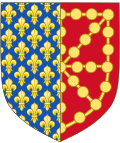
|

|
? | Arms of France Ancient dimidiated with the arms of Navarre, after king Louis X inherited Navare from his mother Joan I of Navarre in 1305. | |
| 1328–1376 | 
|

|

|
The arms of France Ancient: Azure semé-de-lis or. After the death of the last direct Capetian in 1328, the kingdom of France passed to the house of Valois through the Salic law, and Navarre passed to the house of Evreux through female line. | |
| 1376–1469 | 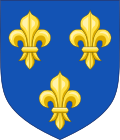
|

|

|
The arms of France Modern: Azure, three fleurs-de-lis or, a simplified version of France Ancient | |
| 1469–1515 | 
|
The arms of France Modern. After the creation of the Order of Saint Michael in 1469, its collar was added to the royal arms. | |||
| 1515–1578 | 
|
The arms of France Modern. King Francis I changed the open crown traditionally used by his predecessors for a closed one. | |||
| 1578–1589 | 
|
The arms of France Modern. After the creation of the Order of the Holy Spirit in 1578, its collar was added to the royal arms. | |||
| 1589–1792 | 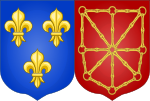
|

|
? | The royal arms of the Kingdom of France after the conclusion of the French Wars of Religion. Again the arms of the Kingdom of Navarre impaled with France Moderne, indicating the personal union of the two realms as a result of Henry IV becoming king. | |
| 1790–1792 | 
|
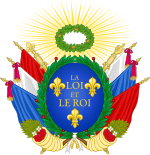
|
Alternative Royal Arms of France. | ||
| First Republic | 1791–1804 | 
|

|
Putative heraldic emblem of the First French Republic | |
| First Empire | 1804–1814/1815 | 
|

|
The arms of the First French Empire of Napoleon I, featuring an eagle, the Crown of Napoleon and inset with "golden bees" as in the tomb of King Childeric I. | |
| Kingdom (Bourbon Restoration) | 1814/1815–1830 | 
|

|
After the Bourbon Restoration, the royal House of Bourbon once more assumed the French crown. | |
| Kingdom (July Monarchy) | 1830–1831 | 
|

|
During the July Monarchy, the arms of the House of Orléans were used. | |
| 1831–1848 | 
|

|
From 1831 onward, the arms of Louis-Philippe were used, depicting the Charter of 1830. (Stars were eventually added to the Mantling; along with addition of Supporters, a decrease of the flags to two, the addition of a helmet, the reversion to the Fleur-de-Lys Crown as one of the two Crowns, the flagpoles having spearheads and at the base were two cannons surmounted by floral branches.) | ||
| Second Empire | 1852–1870 | 
|

|
The arms of the Second French Empire of Napoleon III, again featuring an eagle, but now with the Crown of Napoleon III. | |
| Third, Fourth and Fifth Republic | 1905–1953 (greater version), 1905–present (escutcheon) | 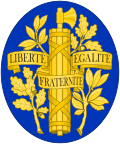
|
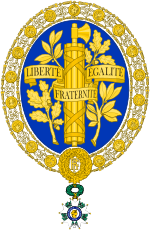
|
Between 1905 and 1953, the middle version of the present coat of arms displayed the 1881 version of the grand collar of the Legion of Honour. |
See also
- Armorial of France
- Armorial of presidents of France
- Armorial of the Capetian dynasty
- National symbols of France
References
- ^ http://www.hubert-herald.nl/FranFrance.htm
- ^ https://www.max-gueguen.com/reception-demmanuel-macron-a-lhotel-de-ville-de-paris/
- ^ https://www.max-gueguen.com/reception-demmanuel-macron-a-lhotel-de-ville-de-paris/
- ^ "Les symboles de la République française". Site de la présidence de la République.
- ^ https://www.unmultimedia.org/s/photo/detail/704/0070477.html
- ^ https://fotw.info/flags/fr).html
- ^ https://www.unmultimedia.org/s/photo/detail/783/0078376.html
- ^ http://www.hubert-herald.nl/FranFrance.htm
- ^ https://bibliotheques-specialisees.paris.fr/ark:/73873/pf0001198956/0066/v0001.simple.selectedTab=otherdocs.hidesidebar
- ^ https://agorha.inha.fr/inhaprod/ark:/54721/00278365
- ^ https://www.123rf.com/photo_44472384_veliky-novgorod-russia-august-17-2015-coat-of-arms-of-france-represented-in-the-hanseatic-fountain-t.html
- ^ https://www.max-gueguen.com/reception-demmanuel-macron-a-lhotel-de-ville-de-paris/
- ^ File:Visites Mitterrand Chirac à l'hôtel de ville de Paris.jpg
External links
- Symbols of France at Flags of the World
- France at Heraldry of the World
- Heraldry of France — Hubert de Vries website
- Les Armes de Strasbourg — Collection du Mobilier national (in French)
